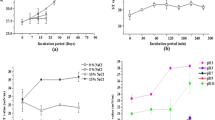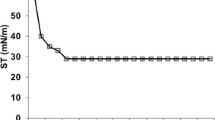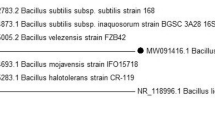Abstract
Highly hydrophobic compounds like petroleum and their byproducts, once released into the environment, can persist indefinitely by virtue of their ability to resist microbial degradation, ultimately paving the path to severe environmental pollution. Likewise, the accumulation of toxic heavy metals like lead, cadmium, chromium, etc., in the surroundings poses an alarming threat to various living organisms. To remediate the matter in question, the applicability of a biosurfactant produced from the mangrove bacterium Bacillus pumilus NITDID1 (Accession No. KY678446.1) is reported here. The structural characterization of the produced biosurfactant revealed it to be a lipopeptide and has been identified as pumilacidin through FTIR, NMR, and MALDI-TOF MS. The critical micelle concentration of pumilacidin was 120 mg/L, and it showed a wide range of stability in surface tension reduction experiments under various environmental conditions and exhibited a high emulsification index of as much as 90%. In a simulated setup of engine oil-contaminated sand, considerable oil recovery (39.78%) by this biosurfactant was observed, and upon being added to a microbial consortium, there was an appreciable enhancement in the degradation of the used engine oil. As far as the heavy metal removal potential of biosurfactant is concerned, as much as 100% and 82% removal was observed for lead and cadmium, respectively. Thus, in a nutshell, the pumilacidin produced from Bacillus pumilus NITDID1 holds promise for multifaceted applications in the field of environmental remediation.
Graphical Abstract









Similar content being viewed by others
Data availability
The authors confirm that the data supporting the study’s finding are included in the article and its supplementary materials. 16S rRNA gene sequence are available in NCBI database.
References
Abdeshahian P, Fooladi T, Hamid AA et al (2016) Characterization, production and optimization of lipopeptide biosurfactant by new strain Bacillus pumilus 2IR isolated from an Iranian oil field. J Pet Sci Eng 145:510–519. https://doi.org/10.1016/j.petrol.2016.06.015
Araújo HWC, Andrade RFS, Montero-Rodríguez D et al (2019) Sustainable biosurfactant produced by Serratia marcescens UCP 1549 and its suitability for agricultural and marine bioremediation applications. Microb Cell Fact 18:1–13. https://doi.org/10.1186/s12934-018-1046-0
Badmus SO, Amusa HK, Oyehan TA, Saleh TA (2021) Environmental risks and toxicity of surfactants: overview of analysis, assessment, and remediation techniques. Environ Sci Pollut Res 28:62085–62104. https://doi.org/10.1007/s11356-021-16483-w
Ben Ayed H, Jemil N, Maalej H et al (2015) Enhancement of solubilization and biodegradation of diesel oil by biosurfactant from Bacillus amyloliquefaciens An6. Int Biodeterior Biodegrad 99:8–14. https://doi.org/10.1016/j.ibiod.2014.12.009
Bezza FA, Chirwa EMN (2015) Production and applications of lipopeptide biosurfactant for bioremediation and oil recovery by Bacillus subtilis CN2. Biochem Eng J 101:168–178. https://doi.org/10.1016/j.bej.2015.05.007
Bezza FA, Chirwa EMN (2016) Biosurfactant-enhanced bioremediation of aged polycyclic aromatic hydrocarbons (PAHs) in creosote contaminated soil. Chemosphere 144:635–644. https://doi.org/10.1016/j.chemosphere.2015.08.027
Bezza FA, Tichapondwa SM, Chirwa EMN (2020) Synthesis of biosurfactant stabilized silver nanoparticles, characterization and their potential application for bactericidal purposes. J Hazard Mater 393:122319. https://doi.org/10.1016/j.jhazmat.2020.122319
Borah D, Yadav RNS (2017) Bioremediation of petroleum based contaminants with biosurfactant produced by a newly isolated petroleum oil degrading bacterial strain. Egypt J Pet 26:181–188. https://doi.org/10.1016/j.ejpe.2016.02.005
Campinas UEDE, Gurjar J, Sengupta B et al (2015) Optimization and characterization of biosurfactant production by Bacillus subtilis isolates towards microbial enhanced oil recovery applications. Fuel 111:259–268. https://doi.org/10.1016/j.biortech.2015.04.013
Chandankere R, Yao J, Cai M et al (2014) Properties and characterization of biosurfactant in crude oil biodegradation by bacterium Bacillus methylotrophicus USTBa. Fuel 122:140–148. https://doi.org/10.1016/j.fuel.2014.01.023
Chaprão MJ, da Silva R, de CFS, Rufino RD, et al (2018) Production of a biosurfactant from Bacillus methylotrophicus UCP1616 for use in the bioremediation of oil-contaminated environments. Ecotoxicology 27:1310–1322. https://doi.org/10.1007/s10646-018-1982-9
Chen Q, Li Y, Liu M et al (2021) Removal of Pb and Hg from marine intertidal sediment by using rhamnolipid biosurfactant produced by a Pseudomonas aeruginosa strain. Environ Technol Innov 22:101456. https://doi.org/10.1016/j.eti.2021.101456
Chittepu OR (2019) Isolation and characterization of biosurfactant producing bacteria from groundnut oil cake dumping site for the control of foodborne pathogens. Grain Oil Sci Technol 2:15–20. https://doi.org/10.1016/j.gaost.2019.04.004
Collivignarelli MC, Carnevale Miino M, Baldi M et al (2019) Removal of non-ionic and anionic surfactants from real laundry wastewater by means of a full-scale treatment system. Process Saf Environ Prot 132:105–115. https://doi.org/10.1016/j.psep.2019.10.022
Cooper DG, Goldenberg BG (1987) Surface-active agents from two Bacillus species. Appl Environ Microbiol 53:224–229. https://doi.org/10.1128/aem.53.2.224-229.1987
Das AJ, Kumar R (2018) Utilization of agro-industrial waste for biosurfactant production under submerged fermentation and its application in oil recovery from sand matrix. Bioresour Technol 260:233–240. https://doi.org/10.1016/j.biortech.2018.03.093
Das AJ, Kumar R (2019) Production of biosurfactant from agro-industrial waste by Bacillus safensis J2 and exploring its oil recovery efficiency and role in restoration of diesel contaminated soil. Environ Technol Innov 16:100450. https://doi.org/10.1016/j.eti.2019.100450
Das P, Mukherjee S, Sen R (2009) Biosurfactant of marine origin exhibiting heavy metal remediation properties. Bioresour Technol 100:4887–4890. https://doi.org/10.1016/j.biortech.2009.05.028
Datta P, Tiwari P, Pandey LM (2018) Isolation and characterization of biosurfactant producing and oil degrading Bacillus subtilis MG495086 from formation water of Assam oil reservoir and its suitability for enhanced oil recovery. Resour Technol. https://doi.org/10.1016/j.biortech.2018.09.047
De Faria AF, Teodoro-Martinez DS, De Oliveira Barbosa GN et al (2011) Production and structural characterization of surfactin (C 14/Leu7) produced by Bacillus subtilis isolate LSFM-05 grown on raw glycerol from the biodiesel industry. Process Biochem. https://doi.org/10.1016/j.procbio.2011.07.001
De Oliveira EM, Sales VHG, Andrade MS et al (2021) Isolation and characterization of biosurfactant-producing bacteria from amapaense amazon soils. Int J Microbiol. https://doi.org/10.1155/2021/9959550
de Oliveira JG, Garcia-Cruz CH (2013) Properties of a biosurfactant produced by Bacillus pumilus using vinasse and waste frying oil as alternative carbon sources. Brazilian Arch Biol Technol 56:155–160. https://doi.org/10.1590/S1516-89132013000100020
El-Sheshtawy HS, Aiad I, Osman ME et al (2015) Production of biosurfactant from Bacillus licheniformis for microbial enhanced oil recovery and inhibition the growth of sulfate reducing bacteria. Egypt J Pet 24:155–162. https://doi.org/10.1016/j.ejpe.2015.05.005
Gomaa EZ, El-Meihy RM (2019) Bacterial biosurfactant from Citrobacter freundii MG812314.1 as a bioremoval tool of heavy metals from wastewater. Bull Natl Res Cent. https://doi.org/10.1186/s42269-019-0088-8
Gonçalves LRB, de Santana HB, Melo VMM et al (2015) Production of a biosurfactant by Bacillus subtilis ICA56 aiming bioremediation of impacted soils. Catal Today 255:10–15. https://doi.org/10.1016/j.cattod.2015.01.046
Gudiña EJ, Fernandes EC, Rodrigues AI et al (2015) Biosurfactant production by Bacillus subtilis using corn steep liquor as culture medium. Front Microbiol 6:1–7. https://doi.org/10.3389/fmicb.2015.00059
Hassanshahian M (2014) Isolation and characterization of biosurfactant producing bacteria from Persian Gulf (Bushehr provenance). Mar Pollut Bull 86:361–366. https://doi.org/10.1016/j.marpolbul.2014.06.043
Hentati D, Chebbi A, Hadrich F et al (2019) Production, characterization and biotechnological potential of lipopeptide biosurfactants from a novel marine Bacillus stratosphericus strain FLU5. Ecotoxicol Environ Saf 167:441–449. https://doi.org/10.1016/j.ecoenv.2018.10.036
Ismail W, Al-Rowaihi IS, Al-Humam AA et al (2013) Characterization of a lipopeptide biosurfactant produced by a crude-oil-emulsifying Bacillus sp. I-15. Int Biodeterior Biodegrad 84:168–178. https://doi.org/10.1016/j.ibiod.2012.04.017
Jemil N, Manresa A, Rabanal F et al (2017) Structural characterization and identification of cyclic lipopeptides produced by Bacillus methylotrophicus DCS1 strain. J Chromatogr B Anal Technol Biomed Life Sci 1060:374–386. https://doi.org/10.1016/j.jchromb.2017.06.013
Joshi S, Bharucha C, Desai AJ (2008) Production of biosurfactant and antifungal compound by fermented food isolate Bacillus subtilis 20B. Bioresour Technol 99:4603–4608. https://doi.org/10.1016/j.biortech.2007.07.030
Joy S, Rahman PKSM, Sharma S (2017) Biosurfactant production and concomitant hydrocarbon degradation potentials of bacteria isolated from extreme and hydrocarbon contaminated environments. Chem Eng J 317:232–241. https://doi.org/10.1016/j.cej.2017.02.054
Ju M, Li X, Yu Q et al (2016) Purification and characterization of biosurfactant produced by Bacillus licheniformis Y-1 and its application in remediation of petroleum contaminated soil. Mar Pollut Bull 107:46–51. https://doi.org/10.1016/j.marpolbul.2016.04.025
Khopade A, Ren B, Liu XY et al (2012) Production and characterization of biosurfactant from marine Streptomyces species B3. J Colloid Interface Sci 367:311–318. https://doi.org/10.1016/j.jcis.2011.11.009
Li J, Deng M, Wang Y, Chen W (2016) Production and characteristics of biosurfactant produced by Bacillus pseudomycoides BS6 utilizing soybean oil waste. Int Biodeterior Biodegrad 112:72–79. https://doi.org/10.1016/j.ibiod.2016.05.002
Liu Q, Lin J, Wang W et al (2014) Production of surfactin isoforms by Bacillus subtilis BS-37 and its applicability to enhanced oil recovery under laboratory conditions. Biochem Eng J 93:31–37. https://doi.org/10.1016/j.bej.2014.08.023
Long X, He N, He Y et al (2017) Biosurfactant surfactin with pH-regulated emulsification activity for efficient oil separation when used as emulsifier. Bioresour Technol 241:200–206. https://doi.org/10.1016/j.biortech.2017.05.120
Luna JM, Rufino RD, Sarubbo LA (2016) Biosurfactant from Candida sphaerica UCP0995 exhibiting heavy metal remediation properties. Process Saf Environ Prot 102:558–566. https://doi.org/10.1016/j.psep.2016.05.010
Mani P, Sivakumar P, Balan SS (2016) Economic production and oil recovery efficiency of a lipopeptide biosurfactant from a Novel marine bacterium Bacillus simplex. Achiev Life Sci 10:102–110. https://doi.org/10.1016/j.als.2016.05.010
Mendes PM, Ribeiro JA, Martins GA et al (2021) Phytotoxicity test in check: Proposition of methodology for comparison of different method adaptations usually used worldwide. J Environ Manage. https://doi.org/10.1016/j.jenvman.2021.112698
Mishra S, Lin Z, Pang S et al (2021) Biosurfactant is a powerful tool for the bioremediation of heavy metals from contaminated soils. J Hazard Mater 418:126253. https://doi.org/10.1016/j.jhazmat.2021.126253
Mnif I, Sahnoun R, Ellouz-Chaabouni S, Ghribi D (2017) Application of bacterial biosurfactants for enhanced removal and biodegradation of diesel oil in soil using a newly isolated consortium. Process Saf Environ Prot 109:72–81. https://doi.org/10.1016/j.psep.2017.02.002
Muthukamalam S, Sivagangavathi S, Dhrishya D, Sudha Rani S (2017) Characterization of dioxygenases and biosurfactants produced by crude oil degrading soil bacteria. Brazilian J Microbiol 48:637–647. https://doi.org/10.1016/j.bjm.2017.02.007
Nayak NS, Purohit MS, Tipre DR, Dave SR (2020) Biosurfactant production and engine oil degradation by marine halotolerant Bacillus licheniformis LRK1. Biocatal Agric Biotechnol 29:101808. https://doi.org/10.1016/j.bcab.2020.101808
Ohadi M, Dehghannoudeh G, Forootanfar H et al (2018) Investigation of the structural, physicochemical properties, and aggregation behavior of lipopeptide biosurfactant produced by Acinetobacter junii B6. Int J Biol Macromol 112:712–719. https://doi.org/10.1016/j.ijbiomac.2018.01.209
Pandey R, Krishnamurthy B, Singh HP, Batish DR (2022) Evaluation of a glycolipopepetide biosurfactant from Aeromonas hydrophila RP1 for bioremediation and enhanced oil recovery. J Clean Prod 345:131098. https://doi.org/10.1016/j.jclepro.2022.131098
Pathak KV, Keharia H (2014) Application of extracellular lipopeptide biosurfactant produced by endophytic Bacillus subtilis K1 isolated from aerial roots of banyan (Ficus benghalensis) in microbially enhanced oil recovery (MEOR). 3 Biotech 4:41–48. https://doi.org/10.1007/s13205-013-0119-3
Patowary K, Patowary R, Kalita MC, Deka S (2017) Characterization of biosurfactant produced during degradation of hydrocarbons using crude oil as sole source of carbon. Front Microbiol 8:1–14. https://doi.org/10.3389/fmicb.2017.00279
Phulpoto IA, Jakhrani BA, Phulpoto AH et al (2020) Enhanced oil recovery by potential biosurfactant-producing halo-thermotolerant bacteria using soil washing and sand-packed glass column techniques. Curr Microbiol 77:3300–3309. https://doi.org/10.1007/s00284-020-02172-3
Purwasena IA, Astuti DI, Syukron M et al (2019) Stability test of biosurfactant produced by Bacillus licheniformis DS1 using experimental design and its application for MEOR. J Pet Sci Eng 183:106383. https://doi.org/10.1016/j.petrol.2019.106383
Ravindran A, Sajayan A, Priyadharshini GB et al (2020) Revealing the efficacy of thermostable biosurfactant in heavy metal bioremediation and surface treatment in vegetables. Front Microbiol 11:1–11. https://doi.org/10.3389/fmicb.2020.00222
Saggese A, Culurciello R, Casillo A et al (2018) A marine isolate of Bacillus pumilus secretes a pumilacidin active against staphylococcus aureus. Mar Drugs 16:1–13. https://doi.org/10.3390/md16060180
Sajna KV, Sukumaran RK, Gottumukkala LD, Pandey A (2015) Crude oil biodegradation aided by biosurfactants from Pseudozyma sp. NII 08165 or its culture broth. Bioresour Technol 191:133–139. https://doi.org/10.1016/j.biortech.2015.04.126
Sarubbo LA, da Silva MGC, Durval IJB et al (2022) Biosurfactants: production, properties, applications, trends, and general perspectives. Biochem Eng J. https://doi.org/10.1016/j.bej.2022.108377
Sasser M (2001) Identification of bacteria by gas chromatography of cellular fatty acids. Tech Note 101:1–6
Sharma AD, Singh J (2005) A nonenzymatic method to isolate genomic DNA from bacteria and actinomycete. Anal Biochem 337:354–356. https://doi.org/10.1016/j.ab.2004.11.029
Sharma S, Pandey LM (2020) Production of biosurfactant by Bacillus subtilis RSL-2 isolated from sludge and biosurfactant mediated degradation of oil. Bioresour Technol 307:123261. https://doi.org/10.1016/j.biortech.2020.123261
Sharma D, Pruthi V, Al Ghamdi A et al (2015) Structural characterization and antimicrobial activity of a biosurfactant obtained from Bacillus pumilus DSVP18 grown on potato peels. Jundishapur J Microbiol. https://doi.org/10.5812/jjm.21257
Sharma R, Singh J, Verma N (2018) Production, characterization and environmental applications of biosurfactants from Bacillus amyloliquefaciens and Bacillus subtilis. Biocatal Agric Biotechnol 16:132–139. https://doi.org/10.1016/j.bcab.2018.07.028
Sharma S, Verma R, Pandey LM (2019) Crude oil degradation and biosurfactant production abilities of isolated Agrobacterium fabrum SLAJ731. Biocatal Agric Biotechnol 21:101322. https://doi.org/10.1016/j.bcab.2019.101322
Sharma J, Kapley A, Sundar D, Srivastava P (2022) Characterization of a potent biosurfactant produced from Franconibacter sp. IITDAS19 and its application in enhanced oil recovery. Colloids Surfaces B Biointerfaces 214:112453. https://doi.org/10.1016/j.colsurfb.2022.112453
Shibulal B, Joshi S, Al-Bemani A et al (2013) Biosurfactant production by Bacillus subtilis B30 and its application in enhancing oil recovery. Colloids Surf B Biointerfaces 114:324–333. https://doi.org/10.1016/j.colsurfb.2013.09.022
Silva SNRL, Farias CBB, Rufino RD et al (2010) Glycerol as substrate for the production of biosurfactant by Pseudomonas aeruginosa UCP0992. Colloids Surf B Biointerfaces 79:174–183. https://doi.org/10.1016/j.colsurfb.2010.03.050
Sriram MI, Kalishwaralal K, Deepak V et al (2011) Biofilm inhibition and antimicrobial action of lipopeptide biosurfactant produced by heavy metal tolerant strain Bacillus cereus NK1. Colloids Surf B Biointerfaces 85:174–181. https://doi.org/10.1016/j.colsurfb.2011.02.026
Sun W, Zhu B, Yang F et al (2021) Optimization of biosurfactant production from Pseudomonas sp. CQ2 and its application for remediation of heavy metal contaminated soil. Chemosphere 265:129090. https://doi.org/10.1016/j.chemosphere.2020.129090
Suthar H, Hingurao K, Desai A, Nerurkar A (2008) Evaluation of bioemulsifier mediated microbial enhanced oil recovery using sand pack column. J Microbiol Methods 75:225–230. https://doi.org/10.1016/j.mimet.2008.06.007
Tekinay T, Angun P, Han D et al (2015) Production and structural characterization of biosurfactant produced by newly isolated Staphylococcus xylosus STF1 from petroleum contaminated soil. J Pet Sci Eng 133:689–694. https://doi.org/10.1016/j.petrol.2015.07.011
Yalçın HT, Ergin-Tepebaşı G, Uyar E (2018) Isolation and molecular characterization of biosurfactant producing yeasts from the soil samples contaminated with petroleum derivatives. J Basic Microbiol 58:782–792. https://doi.org/10.1002/jobm.201800126
Yin J, Wei X, Hu F et al (2023) Halotolerant Bacillus velezensis sustainably enhanced oil recovery of low permeability oil reservoirs by producing biosurfactant and modulating the oil microbiome. Chem Eng J. https://doi.org/10.1016/j.cej.2022.139912
Zargar AN, Lymperatou A, Skiadas I et al (2022) Structural and functional characterization of a novel biosurfactant from Bacillus sp IITD106. J Hazard Mater. https://doi.org/10.1016/j.jhazmat.2021.127201
Zhang J, Xue Q, Gao H et al (2016) Production of lipopeptide biosurfactants by Bacillus atrophaeus 5–2a and their potential use in microbial enhanced oil recovery. Microb Cell Fact 15:1–11. https://doi.org/10.1186/s12934-016-0574-8
Zhang J, Feng W, Xue Q (2022) Biosurfactant production and oil degradation by Bacillus siamensis and its potential applications in enhanced heavy oil recovery. Int Biodeterior Biodegrad 169:105388. https://doi.org/10.1016/j.ibiod.2022.105388
Zhou H, Liu Q, Jiang L et al (2023) Enhanced remediation of oil-contaminated intertidal sediment by bacterial consortium of petroleum degraders and biosurfactant producers. Chemosphere 330:138763. https://doi.org/10.1016/j.chemosphere.2023.138763
Acknowledgements
Authors thank NIT Durgapur for AAS and TG analysis, Xcelris Labs Ltd, Ahmadabad for microbial identification, Royal Life Sciences Pvt. Ltd., Secunderabad for GC-FAME analysis, Bose Institute, Kolkata for MALDI-TOF and FTIR analysis, IIT Kharagpur for using tensiometer instrument, TCG life sciences Pvt Ltd, Kolkata for 1H NMR analysis and IISER Kolkata for GC analysis. We also thank Dr. Sudipa Mondal for helping us with the analysis of characterization data.
Funding
The author declare that no funds, grants, or other support were received during the preparation of this manuscript.
Author information
Authors and Affiliations
Contributions
AD performed all the experiments, initial data analysis and prepared the initial draft of the manuscript. SS carried out major data analysis, figure and graph preparation and revised the draft manuscript. PG performed sub-experiment under Phyto-toxicity assay, revised and edited the final version of the manuscript. ID carried out isolation and identification of bacteria. DD and SC supervised the work and carried out review and editing of final draft. All authors read and consented on the manuscript.
Corresponding author
Ethics declarations
Conflict of interest
The authors declare that they have no conflict of interest.
Additional information
Communicated by Yusuf Akhter.
Publisher's Note
Springer Nature remains neutral with regard to jurisdictional claims in published maps and institutional affiliations.
Supplementary Information
Below is the link to the electronic supplementary material.
Rights and permissions
Springer Nature or its licensor (e.g. a society or other partner) holds exclusive rights to this article under a publishing agreement with the author(s) or other rightsholder(s); author self-archiving of the accepted manuscript version of this article is solely governed by the terms of such publishing agreement and applicable law.
About this article
Cite this article
Dasgupta, A., Saha, S., Ganguli, P. et al. Characterization of pumilacidin, a lipopeptide biosurfactant produced from Bacillus pumilus NITDID1 and its prospect in bioremediation of hazardous pollutants. Arch Microbiol 205, 274 (2023). https://doi.org/10.1007/s00203-023-03619-4
Received:
Accepted:
Published:
DOI: https://doi.org/10.1007/s00203-023-03619-4




